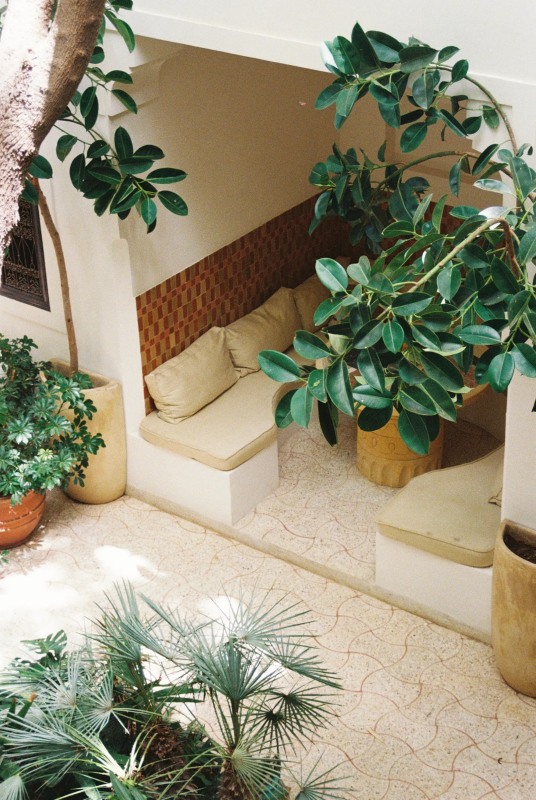In Marrakech, a New Wave of Design-Forward Riads and Farm Stays Takes Root
“Before Marrakech, everything was black,” Yves Saint Laurent once said. The city’s labyrinthine streets, vibrant markets, and welcoming host culture proved to be a fount of inspiration for the 20th century’s jet set, including Saint Laurent himself but also Mick Jagger, Paul and Talitha Getty, Jane Birkin, and more. The thing is—Marrakech isn’t the type of place you go just once. This isn’t the beach resort you reserve for your honeymoon, or the grand one-and-done safari where a single trip feels like enough. This city is a near-unknowable chameleon, ever-changing in its complexity, inviting endless return visits. There are still glimmers of that jet set past; but more excitingly, there are glimpses of its future, too.
If you haven’t been in several years (or ever), now is an excellent time to visit. Since the recent earthquakes, the general consensus in Morocco appears to be a resounding, whole-hearted invitation for the world to come visit: tourism dollars are more crucial than ever in driving on-the-ground economies and supporting local jobs. And while there are a handful of museums and attractions in Marrakech that are temporarily closed for structural repairs, you can always save those for a return visit—to my earlier point, Marrakech is the kind of place where you’ll be back.
That’s why the arrival of several gorgeous, design-forward riads this year feels especially apropos—each provides a quintessentially Moroccan experience, yet also imagines its own unique future for this country’s unique brand of haute bohemianism. Here are three to bookmark for your next journey through the Red City.
Izza
“This was never intended to be a hotel,” said Tim Slee, director of the new Izza, a 14-room riad nestled in the heart of the Medina. “The original incarnation was to be a nice, private riad for our owner [a private family office in London,] and their guests to come enjoy.” But after Slee pinpointed the first ideal property to purchase, he discovered a second adjoining one that had a pool, and then a subsequent one with a rooftop—then, as one does, he ended up purchasing a warren of eight interconnected riads.
One of those structures is the former home of famed interior designer Bill Willis, an American expat and designer credited with some of the jet set’s more fabulous interiors. His influence carries on throughout Izza both literally and figuratively: A slew of his old letters with Saint Laurent, Mick Jagger, Grace Jones, and more adorn the walls of the hotel; and Slee also shared that Izza’s ownership is in the process of creating a Bill Willis Foundation, so that the Willis house can be used for an artist residency program moving forward.
As for the hotel itself, the renovation is nothing short of stunning. Over 300 works of art adorn the walls, and there are plenty of nooks, crannies, and lounges from which to admire them all. Other highlights include a lap pool (a rare find considering Izza’s location in the Medina), as well as one of the largest rooftop terraces in the area. When you’re up there for sunset, listening to the gentle sounds of the streets below, there’s a sense that Saint Laurent himself has just stepped away from the dinner table and might return at any moment.
Rosemary
Belgian artist and expat Laurence Leenaert has built a name for herself in Marrakech for her studio LRNCE, which produces ceramics, textiles, gifts, and all sorts of objets. Now, with the opening of Rosemary, the next art form she seeks to conquer is hospitality itself.
“I thought it would be nice to have a place where people could experience all of our products in one space,” said Leenaert. While her studio on the outskirts of Marrakech is already a popular must-visit for design lovers, the chance to actually step inside her world in the form of a renovated riad is something altogether different. At Rosemary, she had to think about her products not individually, but in terms of how they could fit together to create an overarching atmosphere—including how they interact with all the banal design details that go into a hotel like toilet paper holders and doorknobs. Leeneart kept the building’s architecture very Moroccan, but used those cool, neutral spaces as a blank canvas in which to display her colorful work, and worked closely with artisans to update old-world techniques in modern ways. The result is a totally different type of riad where authenticity gets a fresh interpretation—there aren’t many riads out there with terrazzo floors, abstract plasterwork, and stained-glass windows inspired by Botticelli’s The Birth of Venus.

